Getting Started In Stand Up Paddleboarding (SUP) - Part 2
Getting Started In Stand Up Paddleboarding (SUP)
by Kim Evans
Part 2
So you now have your board, paddle, PFD, and leash. Now what? It is time to get that stand up paddleboard on the water and begin enjoying the fun sport of SUPing! Since you are new to the sport, take your board to a body of water that is calm so that you can get accustomed to being on the board without having to worry about big waves or current. But be prepared to spend a bit of time IN the water as well!
Launching the board
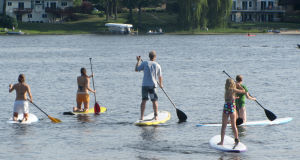 Bring your board down to the beach or bank, and gently set it down on shore fin up. Make sure you have everything, and be sure that you don't have anything with you that shouldn't get wet, such as a cell phone or camera, or something that you could lose, like keys or glasses. Keep your valuables in your car, or sealed up tight in a waterproof bag that you can attach to you in some way. It would be a real bummer to lose your keys in the water. Attach the leash to the end of the board, and either strap your PFD to the board or put it on.
Bring your board down to the beach or bank, and gently set it down on shore fin up. Make sure you have everything, and be sure that you don't have anything with you that shouldn't get wet, such as a cell phone or camera, or something that you could lose, like keys or glasses. Keep your valuables in your car, or sealed up tight in a waterproof bag that you can attach to you in some way. It would be a real bummer to lose your keys in the water. Attach the leash to the end of the board, and either strap your PFD to the board or put it on.
Carefully flip your board over and slide it into the water, keeping the fin lifted out. Walk your paddle board out until it is floating, with the fin having about six inches of clearance, and then climb on. You want to get yourself on the middle of the board, starting on your knees. You should be straddling the handle, which is roughly at the center of the board. Pick up your paddle.
Standing up
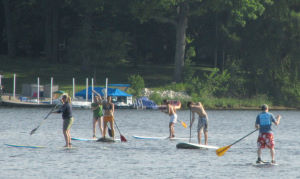 Stay up on your knees and paddle around for a bit to get used to being on the board and assess the conditions. Then, while the board is moving, set your paddle down across the board and curl your toes underneath you. With your hands on the paddle, stand up. Make sure that you do it in one continuous motion, and commit to being upright! If you hesitate, all may be lost and you could go in the water. If it doesn't feel right, settle back on your knees and try again. Once up, take a few strokes with the paddle to keep moving. A paddle board is similar to a bicycle; it is better balanced while moving and tippier when it is not in motion.
Stay up on your knees and paddle around for a bit to get used to being on the board and assess the conditions. Then, while the board is moving, set your paddle down across the board and curl your toes underneath you. With your hands on the paddle, stand up. Make sure that you do it in one continuous motion, and commit to being upright! If you hesitate, all may be lost and you could go in the water. If it doesn't feel right, settle back on your knees and try again. Once up, take a few strokes with the paddle to keep moving. A paddle board is similar to a bicycle; it is better balanced while moving and tippier when it is not in motion.
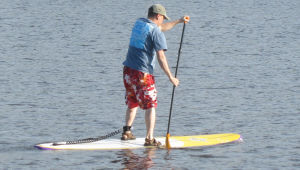 Once you have made it to standing, check to make sure your feet are in the general area of the center of the board. Your feet should be shoulder width apart, giving you a solid, sturdy stance. Your knees should be loose with some give in them. Your paddle should be situated with one hand on top and the other down at least two to two-and-a-half feet. Draw the blade along the side of the board and you are in business! Take some strokes on one side of the board and then switch hands. When you switch, take the top hand off and put it down by your other hand, then move that hand to the handle. That way you will have your two hands in about the same spot each time. Your top hand pushes the paddle; the bottom hand pulls the paddle.
Once you have made it to standing, check to make sure your feet are in the general area of the center of the board. Your feet should be shoulder width apart, giving you a solid, sturdy stance. Your knees should be loose with some give in them. Your paddle should be situated with one hand on top and the other down at least two to two-and-a-half feet. Draw the blade along the side of the board and you are in business! Take some strokes on one side of the board and then switch hands. When you switch, take the top hand off and put it down by your other hand, then move that hand to the handle. That way you will have your two hands in about the same spot each time. Your top hand pushes the paddle; the bottom hand pulls the paddle.
Turning the board
When you want to turn your board, the easiest thing to do is to just paddle on one side and go around in a big circle. It may take a while, but it works. To turn a bit quicker, put the paddle in the water and as you draw the blade back, sweep the blade away from the board. You will turn in the opposite direction. The other turn that you can do is a reverse turn. Put the paddle into the water at the back of the board and pull the blade forward. That will pull the board in the opposite direction. Make sure that you are gripping the board with your feet so that you do not pull yourself off of the board in the process!
Getting back up on the board
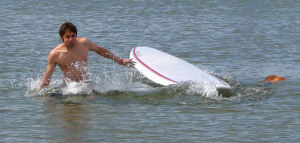 Everyone falls in at one time or another. When you do fall in, let go of your paddle. You can hit the bottom with the blade and jab yourself with the handle, or even worse break your paddle. So just let go - it floats. After you are in the water, get back to your board along the side. Reach across to the opposite side of the board and pull yourself back on the board. Not pretty or graceful, but you will get back on. If your board has high rails and you just can't get yourself up from the side, go to the back end, push it down and try climbing on that way. Then stay down on your board and dog paddle to retrieve your paddle. Board first, paddle second.
Everyone falls in at one time or another. When you do fall in, let go of your paddle. You can hit the bottom with the blade and jab yourself with the handle, or even worse break your paddle. So just let go - it floats. After you are in the water, get back to your board along the side. Reach across to the opposite side of the board and pull yourself back on the board. Not pretty or graceful, but you will get back on. If your board has high rails and you just can't get yourself up from the side, go to the back end, push it down and try climbing on that way. Then stay down on your board and dog paddle to retrieve your paddle. Board first, paddle second.
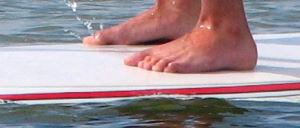 So now you are on the board, you have gotten used to it and you are finally looking up from the tip of your board! This is awesome, right? SUPing is SO cool! But wait! Your toes are feeling really weird! Yup...that happens. Stand up paddling is really not just standing on the board. You are keeping yourself ON the board with your feet by gripping the surface. If you hold your feet in that position for too long, your toes can get fatigued. So once you are more comfortable on the board, you can relax your feet a bit, shift your weight, wiggle those toes.....anything that helps those feet feel a bit more normal. If your back hurts, use your whole body while paddling, not just your arms and shoulders. The more you move around the better you will feel.
So now you are on the board, you have gotten used to it and you are finally looking up from the tip of your board! This is awesome, right? SUPing is SO cool! But wait! Your toes are feeling really weird! Yup...that happens. Stand up paddling is really not just standing on the board. You are keeping yourself ON the board with your feet by gripping the surface. If you hold your feet in that position for too long, your toes can get fatigued. So once you are more comfortable on the board, you can relax your feet a bit, shift your weight, wiggle those toes.....anything that helps those feet feel a bit more normal. If your back hurts, use your whole body while paddling, not just your arms and shoulders. The more you move around the better you will feel.
There you have it, the basics of SUP. Have fun and enjoy one of the best new water sports around!
Oh, and be sure to check out this video with some basic tips!
